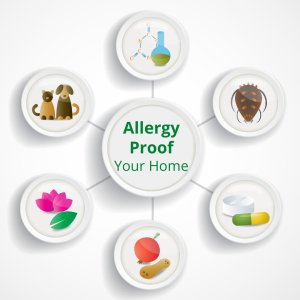6 Smart Steps to Allergy-Proof Your Home - Escarosa

Allergy season is here. You are not alone if you’re feeling a little sneezy, wheezy, or congested lately. Unfortunately for allergy sufferers, though, spring is not the only time allergens enter the air and wreak havoc on our days. Our homes are full of allergens all year round! Fortunately, you can take steps to allergy-proof your home and breathe a little easier indoors.
This blog will break down the causes of indoor allergens and the most common ways to get rid of them. Improving your home’s indoor air quality starts here!
Let’s dive in.
Where do Allergens Come From?
Hay fever affects 400 million people worldwide, asthma affects 300 million people, and food allergies affect 200-250 million people.
The bottom line?
Allergens are everywhere. Defined simply as molecules that can cause allergy, allergens like tree pollen, mold, dust mites, and dander are always all around us.
The problem arises when the body mistakes these substances as a threat. When that happens, the immune system flares up, and we develop allergies. This process is why nobody is ever born with allergies. Instead, we develop them when our immune systems encounter foreign molecules. That’s why taking steps to allergy-proof your home is so important.
6 Steps to Allergy-Proof Your Space
Do you suffer from allergies every year? Do you want to make your home a healthier place? No matter what the case may be, these six steps can help your space feel cleaner, fresher, and allergy-free:
1. Clear the clutter
One of the easiest ways to control indoor allergens is to clear the clutter out of your space. Dust mites love cluttered, cramped environments where dust can gather.
Here’s what the American Lung Association says about these yucky house guests:
“Unlike pet allergens, dust mite allergens do not usually stay airborne but instead settle within minutes into dust or fabrics. These allergens commonly cling to bedding, mattresses, upholstered furniture, carpets, and curtains, which also serve as nests. Most exposure to dust mite allergens occurs while sleeping and when the dust is disturbed during bed-making or other movements.”
Are you feeling grossed out? Don’t worry – there are ways to minimize contact with dust mites.
Here’s what we recommend:
-
Regularly clean your carpets and area rugs. We recommend at least annually, twice a year if have children and/or pets.
-
Replace heavy drapes with washable curtains.
-
Get rid of overstuffed furniture and have sofas, chairs, and other textiles cleaned regularly.
-
Wash your bedding in hot water weekly. Have your mattress cleaned at least once a year.
These tips may seem simple, but they’re a great way to send dust mites packing.
2. Vacuum regularly
Vacuuming at least once or twice a week is a great way to help keep allergens low. Which vacuum you use matters, however.
For best results, choose a vacuum with a powerful HEPA filter. These vacuums are designed for allergy-prone homes and can suck up and secure pet dander, dust, and other allergens.
If you have allergies, wear a mask while you vacuum. After vacuuming, use a damp cloth to dust horizontal surfaces.
3. Have your carpets and upholstery cleaned
While carpets and upholstery make your home a comfortable place to be, they can also decrease the indoor air quality of your space. Dust, dander, and other allergens get trapped in the fibers of your furniture, leading to decreased indoor air quality and more allergy symptoms.
To combat this, have your carpets and upholstery cleaned at least once a year or more frequently if you live in a house with kids and pets.
Professional carpet and upholstery cleaning removes allergens from the fibers of your textiles and improves your home’s indoor air quality. Studies show that both steam and dry cleaning and regular vacuuming result in significant reductions in house dust mite allergen load.
4. Replace your home’s air filter
The air filters in your HVAC system are the first line of defense as far as outdoor allergens go.
Replace these filters every three months or more frequently if you have kids or pets. This will help the filter do its job – trapping outdoor allergens before they can come inside and start making you sick.
5. Prevent mold spores
Mold is one of the top culprits when it comes to allergies. Unfortunately, it’s also everywhere. As we’ve discussed in other blogs, mold is a natural part of indoor and outdoor environments. However, it becomes a problem when it encounters moisture and starts to grow.
When it comes to your home, keeping mold spores in check also means keeping moisture in check. This means reducing moisture in damp areas of the house, like the bathroom, kitchen, and mudroom. Here are a few tips:
-
Run showers for as brief a time as possible before you get in.
-
Use dehumidifiers to reduce dust mites and mold spores.
-
Keep a humidity monitor in the home.
-
Ensure you’re not overwatering house plants or letting water sit in the drip trays.
-
Fix leaks and other causes of damp areas.
-
Address any water damage immediately, with the help of a professional remediation team.
If you notice mold in your home, you’ll need to contact an expert for mold removal.
6. Install an air purifier
A high-quality indoor air purifier can go a long way toward improving your home’s indoor air quality. Look for one that has a HEPA filter to catch dust mites and mold growth. Place a few air purifiers in your home’s living and sleeping areas for the best results.
Our Team is Here to Help Allergy-Proof Your Pensacola Home
Allergy season can be bad in Florida. Between the pollen, dust, and hay in the air, it can be a difficult season. And that doesn’t even take indoor allergies into account! If you’re feeling congested, stuffy, or miserable, we’re here to help you breathe easier.
We provide carpet cleaning and upholstery cleaning services to remove dust mites, pollen, mold, and other allergens from your textiles and restore your healthy, welcoming home.
Contact us today to learn more about how our team can make your home a healthier place or book your first cleaning appointment.












